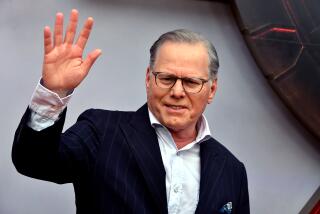‘The Art World Is Ripe for Me’ : Jeff Koons’ high-profile marketing and media manipulation makes his talent seem secondary
Every so often an artist comes along who really seems to bug people and Jeff Koons is this year’s model. A former publicist for the Museum of Modern Art who spent five years on Wall Street selling bonds and futures, the 34-year-old Koons is so adept at deal-making and manipulating the media that his artworks are so much icing on the cake of his career.
Whereas artists have traditionally been highly discreet about marketing strategies, Koons brandishes his like a revolver, and though this bracing slap in the face has collectors clamoring for the opportunity to fork over a few hundred grand for the privilege of owning one of his pieces, (he interviews potential buyers before allowing them the honor), many observers find the artist to be symptomatic of all that is currently wrong with the art world.
“In the late ‘80s the art world is dominated more than ever by the almighty buck and no artist is more informed by this climate than Koons,” comments New York Times art critic Michael Brenson. “At a time when artists have become known for their entrepreneurial skills, he’s brazen in his entrepreneurial ambition and seems to want more money than any artist his age has ever made for art.”
Koons is getting more money too. A recent series of work unveiled last December was executed in an edition of three so that the same exhibition could simultaneously take place in New York, Chicago and Cologne, West Germany. If all the shows sold out (and by now they surely have) Koons stands to take in more than $5 million. Adding insult to injury, Koons promoted the show with a series of glossy ads (shot by glamour photographer Greg Gorman) starring Jeff Koons, made up like a male model and posed at the center of six different scenarios, one of which depicted the artist perched on a throne, proclaiming himself king of the art world.
Shameless grandstanding of this sort doesn’t hit the art world too often so it does tend to make people sit up and take notice. “This is a fabulous time to be an artist, “ crows Koons. “The art world is absolutely ripe for someone like me.”
With his career best described as a series of carefully executed advertising campaigns, Koons has done a masterful job of fabricating an easily identifiable persona for himself, however, his high profile doesn’t necessarily mean he’s well-loved.
“Jeff knows the mechanisms of advertising and media extremely well and that seems to disturb a lot of people,” observes Ann Goldstein, a curator for MOCA who selected Koons as one of 30 artists to be included in “Forest of Signs,” an eagerly anticipated show that opens in May. “His knowledge of those fields is an integral part of his work, which explores the power of representation in the mass media.”
And what do Koons’ explorations of the power of mass media look like? His recent show included “Popples,” a porcelain knock-off of a stuffed rabbit with blue nose and yellow hair ($50,000); a life-sized polychromed wood replica of Buster Keaton on a donkey ($100,000); and a gilded Rococo mirror in the shape of Christ ($150,000). In short, the sort of stuff you’d expect to find in Liberace’s garage. Ostensibly an inquiry into the hidden life of objects and how we relate to our possessions, Koons’ oversized Hummel figures vibrate with the garish, hysterical cheerfulness we associate with shopping malls and amusement parks.
The Koonsian sales pitch that accompanies this bizarre melange of stuffed animals, pop stars and lawn statuary goes something like this:
“My pieces are very bourgeois--in fact, I want them to be the epitome of bourgeois because that is the rallying call of the middle class,” Koons said in an interview at a Beverly Hills hotel. An impeccably mannered man whose unctuous manner leaves a grease stain on every sentence he utters, Koons goes on to explain that “right now I’m very interested in banality and see banality as a savior. The bourgeoisie feels tremendous guilt about their moral position in the world today, but I say to them, embrace your guilt, embrace your banality and move forward. I want to remove the guilt we feel for responding to banality.”
Fed on mass media, Koons is big fan of the advertising industry and has formulated the ideas about class struggle, desire and manipulation that inform his work simply by being a child of his times. His hotel room is littered with popular magazines like Spin, Rolling Stone and the Face, and he confesses that when he watches television, he constantly flips through all 35 channels. Asked what’s currently inspiring him, he mentions rock group Guns N’ Roses. “I like their tattoos and the way they’ve marketed themselves,” he explains. He admits to having been influenced by the ideas of Marcel Duchamp and Andy Warhol, however, his real hero is Michael Jackson. “The responsibility of the artist is to seduce, manipulate and win his negotiations and Michael Jackson is a great negotiator,” he said, glowing with admiration.
Koons’ unique blend of juvenile fantasy and messianic quest is what separates him from the Appropriationist movement with which he was originally associated. Though both Koons and Appropriationism are steeped in irony, Koons’ unbridled lust for attention and the coarse sexuality of his work signal a naivete one isn’t likely to find in work by Appropriationist artists Barbara Kruger or Richard Prince.
“For me, Koons’ work gives off an incredibly powerful feeling of adolescence in its smutty sexuality and desire to shock,” observes New Yorker art critic Adam Gopnik. “His stuff is rebellious in a very adolescent way, and though everyone talks about how shrewdly he’s handled his career, he’s actually done it very crudely. He’s not a very good advertising guy. The striking thing about the ads he recently ran in the art magazines is that they don’t look like ads--they look like a 12-year-old boy’s idea of an ad; me, sexy girls and a lot of stuff. That’s not the way advertising people think. Real ads tend to be much more elliptical and artful.”
Koons lives in New York with his girlfriend of five years, Lizz Lambert, in a full-service hotel near Wall Street. The telephone is his primary creative tool and he doesn’t have a studio because he neither draws nor paints. Rather, he harvests the trends, beliefs and desires that he detects floating through the collective consciousness and selects objects that embody those things. He then takes these objects to fabricators in Northern Italy who reproduce them, thus converting them into exorbitantly expensive avant-garde art.
Expanding on the Duchampian tradition of the ready-made, Koons previous series involved vacuum cleaners encased in plexiglass, basketballs suspended in tanks of water, sports equipment cast in bronze and kitsch bar accessories fabricated in stainless steel. Each of these suites of objects came accompanied by a set of related posters and a new bit of sloganeering (luxury, entropy, degradation and equilibrium are Koons’ favored buzzwords). Keeping a low profile in Manhattan throughout the early ‘80s, Koons emerged as a more or less mature artist in 1985 when he had his first one-man show at the now defunct International With Monument Gallery in New York.
“When I saw Jeff’s first show it was an epiphanous experience,” recalls L.A. dealer Dan Weinberg, an early supporter of Koons’ work. “Here was a guy making sculpture that I had not seen before and my response was immediate and very strong. His work is brilliantly inventive and, treading that fine line between kitsch and fine art as it does, really changes the way we look at sculpture. Whether or not you like his posturing, Jeff has to be taken seriously and if I were making bets on artists today I’d certainly say he’s going to be around for a while.”
Born in York, Pa., Koons has been confident of his talent from the time he was a small child.
“From the time I was 4, I felt like an artist,” he recalls with a warm chuckle. “I have a photo of myself when I was 5 sitting with my crayons just displaying this integrity of being an artist.
“I grew up in a family that moved through the middle-class mobility structure very rapidly,” he continues. “My father was an interior decorator who also sold furniture and he had a store in York. We lived in a small home until I was 5, then we moved to an extremely large house--the largest home in the area in fact. My parents always lived a little beyond their means, but money was never a source of worry in the house, and they joined the local country club and we had horses and kennels. My grandfather was a politician who had a large farm and he collected carriages--kind of elitist, royal, monarchical type carriages, and we’d ride in them in the local parades. I felt like a little prince when I was growing up and I still feel that way today.”
While describing himself as a little prince, Koons insists that his work is, nonetheless, selflessly egalitarian and wholly committed to social change.
“The freedoms that are fought for by art are never fought in the streets,” he says, feverishly smoking a Marlboro. “My work is absolutely Populist. It functions on a wide basis which means it affects all of society, satisfying the needs of everyone and encouraging a leveling of class differentiation.”
“If Jeff Koons’ work is about class struggle, I am Maria of Romania,” counters Time magazine art critic Robert Hughes with a hearty laugh. “Only a fool could believe his work has anything to do with class struggle--he probably knows as much about the subject as Clem Greenberg knows about the history of fly tying in Scotland in the 1890s. Koons’ work has no real aesthetic dimension and is essentially about jargon and hype. It’s making an impact because he’s extremely good at promoting himself, and the art world is grievously ill at the moment.”
That might be the one thing Koons and Hughes agree about. Art’s ever-diminishing power to effect social change is one of Koons’ pet peeves.
“It used to be that if you weren’t good enough to make it in the art world, you’d go into advertising, but now it’s the other way around,” Koons said, launching into one of his favorite raps. “Advertising is much more politically effective than art at this point. As to why I haven’t gone into advertising, I try to incorporate the tools used in advertising and the entertainment industry in my work. Artists must incorporate these things, otherwise we’ll become a completely impotent profession. And right now, art is impotent and totally non-threatening, and that’s why it’s commanding the prices we’ve been seeing lately. Its political statement is almost blank, so corporations can buy it without worrying that it will alter anything at all. Artists used to be the ones who knew how to manipulate, control and meet the needs of the masses, but we’ve lost our power. And I want to bring the power back.”
Exactly how a polychrome wood statue of Michael Jackson cuddling his pet chimpanzee (a Koons’ work titled “Michael Jackson and Bubbles”) is going to revitalize the avant-garde remains to be seen. Koons, however, explains his game plan thus;
“A lot of people have prenotions (sic) about what is good and what is bad, and my work operates in that area between good and bad. Consequently, it challenges their notions about things and hopefully will help them rethink the situation.
“Beyond that, the statuary pieces are fake luxury and they make people feel economically secure when they look at them. The church has always insisted that artworks are for the glory of God, but they also fill the function of making people feel secure, and my objects function in a similar way. We work and sacrifice so that we can accumulate luxury objects which work as support systems for the individual. Our treasured objects fulfill our desires and express them.”
So, what sort of security-inducing objects might one find in Koons’ home?
“I live very simply and don’t keep objects in my home,” he sniffs disdainfully. “The dialogue of consumerism is not something I’m deeply involved with. I’ve been through it and have already digested it.”
Not a particularly Populist point of view, but then Koons is nothing if not a mass of contradictions. He is, however, at all times an astute businessman, and the theoretical fissures that run like a fault line through his work don’t seem to faze the collectors who are currently converting the art world into a speculators’ paradise.
“Koons has been quite open about his abilities as a businessman and of course, that doesn’t bother dealers or collectors at all,” observes New Criterion editor Hilton Kramer. “They love dealing with artists who are businessmen because they talk the same language. Koons’ work is about making money and I find it totally cynical. He’s making an impact because, at the moment, there’s a very low standard of taste in the art world. This presents a tremendous opportunity for people whose only way of making an impact is to lower the standard even further. As for his career longevity, I think he’ll prosper until the next dip in the stock market.”
The New Yorker’s Gopnik disagrees: “Koons may be a very unpleasant talent, but he’s an interesting one and there’s a gleam of true fanaticism about his work. He does what he does at full throttle, he’s invented a language of his own and he’s able to compose sentences in it. I don’t agree with Koons as far as I can understand what his work is claiming, but if you take 20th Century art seriously, one of the things it teaches you is that you have to pay great attention to the disagreeable, the bizarre and offensive as a source of some kind of perverted wisdom. I think this is work in that tradition. That’s not to say Koons is Michelangelo, but I don’t think he’s a charlatan either.”
Koons work may indeed have unplumbed depths, but it will be hard to tell until Koons begins to allow the work to speak for itself; at this point, his art is being upstaged by the sideshow of his career. Koons himself admits with uncharacteristic modesty that he doesn’t have all the bugs out yet.
“I haven’t reached greatness yet but I’m getting close,” he said. “I’m a very good artist--in fact, I’m the best hope for American art and have absolutely assumed the leadership of the art world. I’ve been given the opportunity by our culture to do something great and I want that opportunity--I more than want it, I demand it. Like the people in advertising and entertainment, I’m willing to assume the responsibility of simultaneously meeting the needs and creating the needs. I desire leadership and I’m trying to help set a direction for people.”
What a sales pitch! In parting, one has to ask; how do you feel about the fact that you’re often criticized for your slick sales skills?
“I feel very good about my sales skills because everything is based on sales,” he concludes with pride. “Sales is the front line and no matter what your problem or desire, there’s a sales pitch designed for it. And if, in fact, your product is nothing more than pure salesmanship--that is a fabulous product!”
More to Read
The biggest entertainment stories
Get our big stories about Hollywood, film, television, music, arts, culture and more right in your inbox as soon as they publish.
You may occasionally receive promotional content from the Los Angeles Times.






